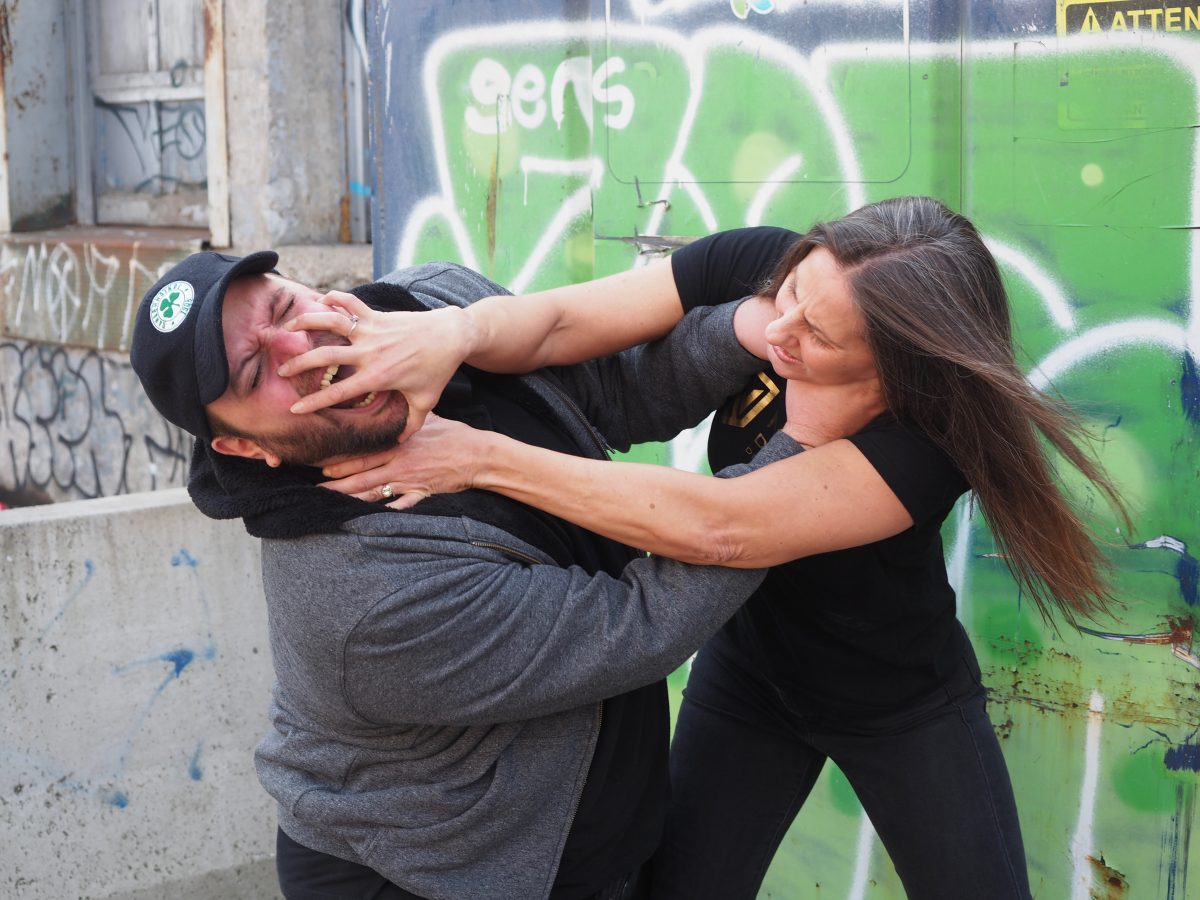Adrenaline is like a drug. They are alike in the chase and the thrill. It can help us, but it could also kill us.
From an evolutionary perspective, adrenaline is the most primitive of hormones, especially amongst early humans.
Spontaneous release into the bloodstream is the body’s response to extreme situations. Its impact is profound for evading injury or fatal attack.
It gave our Darwian ancestors an edge in danger prevention for billions of years, along with other species. They were crude survivalists, constantly evading threats and death from hungry predators.
Being eaten or killed meant they couldn’t reproduce and pass their genes to successive generations. Instead, natural selection and survival of the fittest defined the time, then and now.
Blog: Krav Maga and Cognitive Mindset: Eliminating the Doubt for Survival
Self-defense instruction weighs in on what’s medically known as epinephrine when analyzing fight or flight.
It creates supreme energy, strength, and alertness to reach one’s maximum capacity. To run faster and longer. To be the victor in hand-to-hand combat. To expertly handle a weapon. To escape alive in a street fight.
In the chaos and frenzy of a violent altercation, no isolated strategy or action will guarantee your escape or your life.

The variables of any attack are infinite, and when adrenaline is in the mix, intelligent thinking is disabled. Enter hard-core, real-world training, which you’ll discover is the entire premise of my discipline.
Learning how to control your adrenaline on the daily could be pivotal, even though it’s a neurochemical naturally released into the brain in response to potential danger, stress, or fear.
Adrenaline triggers the fight-or-flight response we incorporate into all our Krav Maga blogs. But the role of adrenaline is broad and not restricted to the world of self-defense, so understanding adrenaline and all its idiosyncrasy are, in reality, for everyone.
Despite the gifted perks of adrenaline, assessing its negative influences is also critical; after all, self-defense is about being prepared for anything. So, for the purpose of this blog, we’ll examine adrenaline in a street fight from all angles. The good. The bad. And the ugly.
The origin of the high
The topic of fight-or-flight insinuates itself in most self-defense content – especially in our series of blogs. However, little kudos is given to the man who first discovered the acute stress response in 1915.
Walter Cannon, a physiologist and neurologist at Harvard Medical School identified that specific physical changes in the stomach function in lab animals would occur if frightened or anxious.
Although his origin of focus was digestion, this eureka moment led him to research further and analyze the diverse physiological reactions to stress throughout the body.
Much like animals, Cannon upheld that our brains react full-tilt by actively preparing the body for action to either fight or flee the threat. And what happens to our system is pretty awesome.
Learn how to train your adrenaline in a street fight with our Krav Maga Survival Package!
Some prime physical indications of fight or flight include:
- Release of energy stores
- Accelerated heart rate
- Activated sweat glands
- Increased blood flow to the muscles
- Dilated pupils
- Increased lung capacity
- Reduced flow of saliva and digestive function
- Inhibited bladder and excretory functions
The Science: What sparks the high?
Adrenaline. Its origin is in the amygdala. The almond-shaped structure is located in the limbic system; it’s that tight cluster of almond-shaped cells near the base of the brain. Everyone has two of these cell groups, one in each hemisphere (or side) of the brain.
The amygdala has a slew of functions but is primarily recognized for signaling the body to either fight for survival or flee to safety. It’s a built-in response activated by emotions indicative of stress, fear, anxiety, aggression, and anger.
So just what causes an adrenaline spike? First, your amygdala sets off alarm bells, which causes the hypothalamus to activate the sympathetic nervous system. Next, these distress signals travel through the autonomic nerves to your adrenal glands. Finally, they respond by pumping adrenaline into your bloodstream, preparing you for the fight of your life.

Did you know?
Stress is diverse. Which means it’s not inevitably unhealthy. You experience acute stress multiple times a day, and not only is it prevailing, but it’s the least harmful of emotional, physical, and psychological tension.
To be clear, these types of threats are not always ‘intense’ and may be classified as moderate or even benign. But, for the most part, they are life’s daily challenges: work, school, and responsibilities which can naturally overwhelm them.
What’s interesting to note is that your perception of the threat triggers adrenaline and the stress response.
For the most part, this acute stress propels energy, improves memory, and motivates you to confront all that is challenging. Once the angst is over or the threat ceases, your symptoms will disappear, along with the secretion of adrenaline.
The good: It’s a high
Adrenaline is a vital self-defense mechanism set off by stress. During a street fight, It takes mere seconds, and when your adrenaline floods through your system, it morphs you into an invincible being.
It heightens your sensations and makes you almost instantly resilient. You could be shot or stabbed, suffer an incredulous beating or broken bones, and you will endure it all.
But this superhuman experience, this good power, is finite. The rush is a short-lived reaction to a threatening stimulus.
Most people are familiar with the automatic function of adrenaline in extreme sports, roller coasters, and daring stunts. Some get off on the rush that it pumps into the body.
Your heart feels like it’s beating out of your chest, your skin is flushed, and your breathing quickens. Clear signs your sympathetic nervous system has been activated. The draw is a visceral fear.
There are personalities who seek the excitement and intensity of an activity that will trigger the high of adrenaline. Professions such as firefighters or emergency rescue are desirable to a select niche of adventure seekers, and are often labeled adrenaline junkies. But, whether for the thrill or the fear, sought after or not – it’s in us all.

The bad: It’s a short high
An adrenaline rush is quite a temporary fix; it’s only lifesaving and all-powerful within the time of the body’s high. The hormone release is designed to give you about 60 seconds of heroic strength, stamina, and speed. After that, whether to flee or fight is a split-second judgment. Our basic survival relies on primal responses, not critical thinking.
This burst of rampant power is fleeting, so if your adrenaline release causes you to freeze when threatened, the outcome is only dire.
On the other hand, if unprepared, an adrenaline release can thwart one’s ability to fight for their life. In a worst-case scenario, one may lose all ability to defend themselves. In fact, paralyzing fear is considered the most primal self-preservation response.
The ugly: It’s also a low
To the untrained, discovering that lifesaving adrenaline has a dark side, is a shocking surprise. Therefore, Krav Maga training and any self-defense course should include ‘how to train adrenaline’ to exercise useful reactions on adrenaline along with even more expansive and diverse preparation for its ugly effects.
Once a dynamic force with extreme speed, strength, perception, and numbness to even the most crippling pain, you will brave a severe adrenaline dump. This colossal drainage to your system is induced by fear or surprise common amongst attack victims. The adverse chemical reaction degrades the physiological system. More precisely – it diminishes motor skills, vision, hearing, and ravishes your arsenal of self-defense and Krav Maga techniques. It’s the adrenaline dump.
The extraordinary abilities you score with a hit of adrenaline also come at a cost to the body. The reflex depletes you of both energy and oxygen, leaving you spent and burned out when the period of increased adrenaline production is over.
In combat sports, an adrenaline dump is why a competitor may struggle to make it through a single round. Quite simply, it’s the stress associated with being on the competition mat, in front of the world, being attacked by a fierce, unknown opponent. Only with subsequent matches or experience in the ring is a fighter better equipped to dodge this negative phenomenon. Proving that knowledge and exposure are key.
What does all this boil down to?
This is a powerful indicator of how stress, exhilaration, and decision-making can spawn a catastrophic situation and one’s worse fate. Self-defense is habituating “fight” reactions for pressure testing; it’s the pinnacle of what I teach.
It’s significant to know that adrenaline-negative effects are heightened by your lack of awareness. Being unable to grasp the realism of a violent attack will only catch you off guard and leave you endangered. By creating adrenaline-induced situations, you will be able to sustain a more controlled level of adrenaline, which can reduce the crippling anxiety of threat and stress.
Experiencing the adrenaline reflex directly is critical for surviving a street fight, and it’s valuable to note that not everyone will endure it quite the same.
To develop your fight reaction, you must train to become aware of your body’s response to adrenaline. The better you can perceive what is happening under duress, the more feasible it will be to use it to your advantage.
My training system incorporates hard-core drills to trigger an adrenaline rush and provoke your fight-or-flight response – and it will feel relentless.
The goal is to mimic a real-world scenario because that’s where the street fight will happen. It will be terrifying and vicious, and you need to have developed true resilience.
The advantages of adrenaline are underplayed despite the superhuman capacity it yields you.
When teaching fight or flight, the most cutting-edge instructors disclose these three physical effects (good, bad, and ugly) to tame this hyperarousal reflex. It’s pivotal to experience the physical and physiological transformation associated with actual combat so you don’t freeze.
Being employed as a nightclub bouncer for over a decade taught me basic street fighting skills. It led me to identify and assess mainstream self-defense vs. reality-based training expertly, and today, I incorporate adrenaline training as a certified and renowned self-defense expert.
Sending your body into alert in practice will excite your adrenal glands and pump out epinephrine; it’s a living lesson in fear infused into several diverse situations and drills.
I design my course to help you master solid endurance, which ultimately means you can perform at your peak for an extended period – something only practice and real-world experience can achieve.
It all comes down to keeping your cool and calming in the frenzy of street fighting to maintain healthy control over your adrenaline rush.
 Nick Drossos is a revered self-defense expert – a title that carries significant weight as it requires a unique perspective on physical and mental safeguarding.
Nick Drossos is a revered self-defense expert – a title that carries significant weight as it requires a unique perspective on physical and mental safeguarding.
He is a disciplined martial artist, sport fighter, and traditional self-defense expert.
Nick’s prestige is based on ‘high stressed’ fight confrontations, and his focus is teaching detection, prevention, setting up for the initial strike, and remaining one step ahead of your attacker.
Nick’s system is current, global, and in hard-core demand. His most recent project is the Krav Maga Survival Package, the ultimate self-defense experience – 10 hours and 100 real self-defense training lessons – satisfaction guaranteed!
Stay safe and stand strong!


